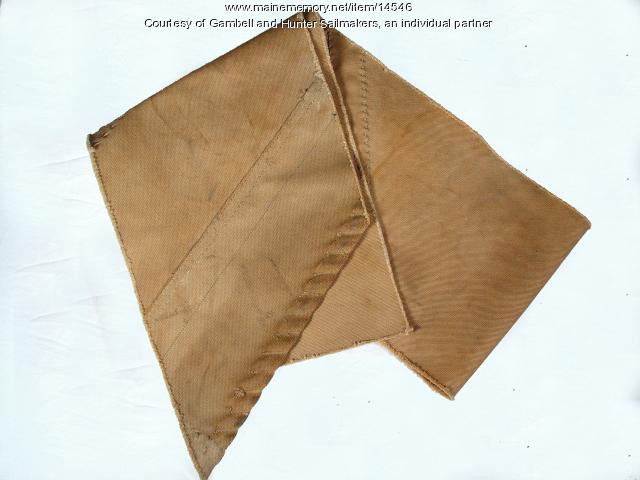Keywords: Sail making
Item 14520
Hand-made canvas sail seam sample, 2003
Courtesy of Gambell and Hunter Sailmakers, an individual partner Date: 2003 Location: Camden Media: Cotton
Item 14546
Fragment of a hand-made canvas sail, ca. 1930
Courtesy of Gambell and Hunter Sailmakers, an individual partner Date: circa 1930 Location: Camden Media: Canvas
Exhibit
Camden has been home to generations of fishermen, shipbuilders, sailmakers, and others who make their living through the sea. The lives of two Camden sailmakers, who were born nearly a century apart, became entwined at a small house on Limerock Street.
Exhibit
The Schooner Bowdoin: Ninety Years of Seagoing History
After traveling to the Arctic with Robert E. Peary, Donald B. MacMillan (1874-1970), an explorer, researcher, and lecturer, helped design his own vessel for Arctic exploration, the schooner <em>Bowdoin,</em> which he named after his alma mater. The schooner remains on the seas.
Site Page
Thomaston: The Town that Went to Sea - Shipbuilding During and after the Civil War - 1861 to 1900
"By holding contracts to produce replacement sails, the firm enjoyed a steady supply of orders. Sail damage was guaranteed in the horrendous storms in…"
Site Page
Mount Desert Island: Shaped by Nature - In the beginning, there were the Wabanaki…
"… years ago, Wabanakis spotted the first European sailing ships cruising along their seacoast. The Wabanaki or Dawnland People* had lived in Maine…"
Story
A Note from a Maine-American
by William Dow Turner
With 7 generations before statehood, and 5 generations since, Maine DNA carries on.
Story
An enjoyable conference, Portland 2021
by John C. Decker, Danville, Pennsylvania
Some snippets from a 4-day conference by transportation historians in Portland, September 7-11, 2021
Lesson Plan
Primary Sources: The Maine Shipyard
Grade Level: 9-12
Content Area: Social Studies
This lesson plan will give students a close-up look at historical operations behind Maine's famed shipbuilding and shipping industries. Students will examine primary sources including letters, bills of lading, images, and objects, and draw informed hypotheses about the evolution of the seafaring industry and its impact on Maine’s communities over time.














